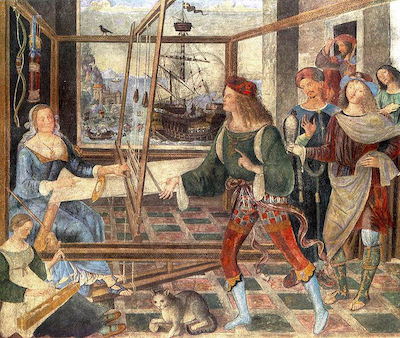Πόροι για τα Ομηρικά έπη: Ο τρωικός μύθος στην τέχνη και τη λογοτεχνία
Πηνελόπη και Μνηστήρες (Pinturicchio, Bernardino)
Περιγραφή
Η τοιχογραφία υπήρξε αρχικά μέρος ενός τρίπτυχου στο Palazzo del Magnifico στη Siena. Πλέον έχει αποσπαστεί από την αρχική της θέση και βρίσκεται τοποθετημένη σε καμβά. Η γυναικεία μορφή καθισμένη στον αργαλειό είναι η Πηνελόπη. The men before her are presumably suitors. The man entering the room is Odysseus disguised as a beggar. Other episodes in the poem are depicted in the distance: Odysseus listens to the song of the sirens strapped to the mast of the ship while his crew block their ears. Sailors in a small boat nearby dive into the water, maddened by the beauty of the singing. On the coast Circe meets Odysseus. Around him are the swine into which this sorceress has turned previous visitors. The painting depicts several layers of narrative telling the story of Penelope, faithful wife of Odysseus, who’s husband had been away for 20 years at the battle of Troy. The scene is articulated inside a room, the prospective depth is shown by the grid-like tiling on the floor and the wooden frame of the loom. In the foreground we see Penelope weaving at her loom, her slow gesture recalling the slosh of the waves, whilst several gaily clad suitors keenly queue for her hand in marriage. In the background of the painting we see two adventure of Odysseus depicted in a large frame which could be a wall size window or canvas. Uninterrupted views into the distance was a frequent feature in antique frescos, and by doing so Pinturicchio provides a second plane of action. On the left we see the island of Circe where the sorceress lived, who had stalled Odysseus by turning the crewmembers into pigs whilst taking Odysseus as her lover. On the right is a ship, with the shape of Odysseus just visible, and tied up, so he could listen to the mermaid song without succumbing to their enchanting power and throwing himself overboard which was the custom. Midground right, a figure is entering in the doorway: It is Odysseus, disguised as an old man, who has returned. Eventually Penelope’s ruse was discovered so she made a second condition which was that she would only wed the man who could fire Odysseus’s bow, which in the painting is hanging above her head. In Homer’ s poem Odysseus then goes on to fire the bow killing all those he considers to be a traitors, Pinturicchio, on the other hand leaves us with a wonderful image, that sits between Gothic and Renaissance in style, where an antique poem is refashioned and the complex narrative becomes a metaphor for fidelity, heroism and justice.Λεξικογραφικές πληροφορίες
Νεότερη Τέχνη
Μουσείο: LONDON The National Gallery NG911
Χρονολογία: 16ος αι. μ.Χ. (1509 περίπου)
Καλλιτέχνης: Pinturicchio, Bernardino
Είδος: Τοιχογραφία (fresco)







